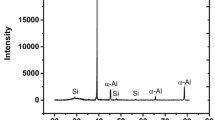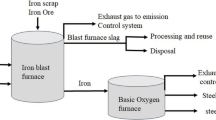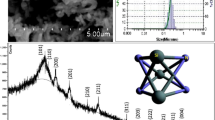Abstract
The present investigation focuses on the development of metal casting mold using stone-dust as an alternative mold material to silica sand. The stone-dust aggregate mold having 4 wt.% of moisture and 11 wt.% of bentonite clay shows desired mold properties as per AFS standard. The mold properties such as permeability number, hardness (B-scale), compressive, and shear strength are 147, 88, 1.48, and 0.33 kgf/cm2, respectively. The fusion point of stone-dust is found to be below 1350 °C and phase changes are observed above 1000 °C. Hence, the stone-dust mold is suitable for Al alloy casting. Therefore, a laboratory-scale casting trial is taken to cast A356 alloy using green stone-dust and silica sand mold. The hardness (HRB), as cast surface roughness (Ra) and microstructure of silica sand and stone-dust mold casting are evaluated and compared. It is observed that stone-dust mold shows higher hardness as compared to silica sand mold. Hence, stone dust mold may be used as an alternative to silica sand in Indian foundries for aluminum alloys casting.






Similar content being viewed by others
References
N.V. Nesterov, A.G. Ermilov, Low-frequency pulsations of melt during lost foam casting process: Part I. Russ. J. Non-ferrous Metals 52(6), 499–503 (2011). https://doi.org/10.3103/S1067821211060095
P. Munusamy, R. Balaji, S. Chinnasamy, Analysis of sand mold using industrial powders and fly ash. Int. J. Mech. Eng. Technol. 8, 292–303 (2017)
J. Palaniappan, Study on Type C Coal Fly ash as an Additive to Molding Sand for Steel Casting. J. Inst. Eng. India Ser. D 98(1), 139–145 (2017). https://doi.org/10.1007/s40033-016-0115-y
P. Karunakaran et al., Sugar industry fly ash: an additive for molding sand to make aluminium castings. Russ. J. Non-ferrous Metals 55(3), 247–253 (2014). https://doi.org/10.3103/S1067821214030079
P. Srinivasa Rao, A. K. Birru, Effect of Mechanical Properties with Addition of Molasses and FlyAsh in Green SandMoulding. Mater. Today Proc. 4(2, Part A), 1186–1192 (2017). https://doi.org/10.1016/j.matpr.2017.01.136.
K. Srinivasan et al., Evaluation of Mechanical Properties, Economic and Environmental Benefits of Partially Replacing Silica Sand with Biomass Ash for Aluminium Casting. Materials Today: Proc. 5(5, Part 2), 12984–12992 (2018). https://doi.org/10.1016/j.matpr.2018.02.283.
P. C. Okonji, C. C. Nwobi-Okoye, P. N. Atanmo, Experimental study of the feasibility of using groundnut shell ash and ant hill powder in foundry application. J. Chin. Adv. Mater. Soc. 6(3), 270–281 (2018). https://doi.org/10.1080/22243682.2018.1461576.
J. B. Rao, I. N. Murthy, Properties of silica sand and GBF slag moulds practiced by Nishiyama process. Int. J. Cast Metals Res. 31(6), 360–372 (2018). https://doi.org/10.1080/13640461.2018.1495862
I. Narasimha Murthy, N. Arun Babu, J. Babu Rao, Microstructure and Mechanical properties of A356 alloy Castings made in Sand and Granulated Blast Furnace Slag Moulds. Mater. Today: Proc. 5(1, Part 1), 161–167 (2018). https://doi.org/10.1016/j.matpr.2017.11.067.
B. R. Jinugu, N. M. Inampudi, Microstructure, SDAS and Mechanical Properties of A356 alloy Castings Made in Sand and Granulated Blast Furnace Slag Moulds. Arch. Foundry Eng. 17 (2017). https://doi.org/10.1515/afe-2017-0033.
I.N. Murthy, J.B. Rao, Molding and casting behavior of ferro chrome slag as a mold material in ferrous and non-ferrous foundry industries. Mater. Manuf. Processes 32(5), 507–516 (2017). https://doi.org/10.1080/10426914.2016.1257796
O. R. Oloyede et al., Evaluation of Structure-Properties Interdependence of Commercial Grey Iron in Silica & Slag Moulds. In: Proceedings of the World Congress on Engineering 2019 (2019).
I.N. Murthy, J.B. Rao, Evaluation of the microstructure, secondary dendrite arm spacing, and mechanical properties of Al–Si alloy castings made in sand and Fe–Cr slag molds. Int J Miner Metall Mater 24(7), 784–793 (2017). https://doi.org/10.1007/s12613-017-1462-x
N. M. Inampudi, B. R. Jinugu, Ferro Chrome Slag: An Alternative Mould Material in Ferrous and Non-ferrous Foundries. Int. J. Metalcast. 11 (2016). https://doi.org/10.1007/s40962-016-0103-x.
P. Karunakaran, Investigation of the properties of molding sand with waste powder from steel industry. Eur. J. Sci. Res. 77, 5–11 (2012)
P.K. Sahoo, S. Pattnaik, M.K. Sutar, Effect of Different Additives on Some Selected Properties of Green Sand Mould. Int. J. Eng. Technol. Sci. Res. IJETSR 4(9), 4 (2017)
A. Singh, “Fly Ash an Alternative for Molding. Int. J. Res. Appl. Sci. Eng. Technol. 6, 525–531 (2018). https://doi.org/10.22214/ijraset.2018.1078].
I. N. Murthy, J. B. Rao, Investigations on physical and chemical properties of high silica sand, Fe-Cr slag and blast furnace slag for foundry applications. Procedia Environ. Sci. 35, 583–596 (2016)
P.H. Kumar et al., Implementation of industrial waste ferrochrome slag in conventional and low cement castables: Effect of microsilica addition. J. Asian Ceramic Societies 2(2), 169–175 (2014)
P.K. Acharya, S.K. Patro, Utilization of ferrochrome wastes such as ferrochrome ash and ferrochrome slag in concrete manufacturing. Waste Manag Res. 34(8), 764–774 (2016). https://doi.org/10.1177/0734242X16654751
A. Yılmaz, M. Karaşahin, Mechanical properties of ferrochromium slag in granular layers of flexible pavements. Mater. Struct. 43(3), 309–317 (2010). https://doi.org/10.1617/s11527-009-9490-2
K. T. Rao, P. S. Babu, Usage of Blast Furnace Slag in Moulding Sand to Produce Al-Mg Alloy Castings. In Proceedings of International Conference on Recent Trends in Mechanical Engineering (2015).
S. Kumar et al., Mechanical activation of granulated blast furnace slag and its effect on the properties and structure of portland slag cement. Cement Concr. Compos. 30(8), 679–685 (2008)
J.I. Escalante-Garcia, R.X. Magallanes-Rivera, A. Gorokhovsky, Waste gypsum–blast furnace slag cement in mortars with granulated slag and silica sand as aggregates. Constr. Build. Mater. 23(8), 2851–2855 (2009)
K.M. Lee et al., Autogenous shrinkage of concrete containing granulated blast-furnace slag. Cem. Concr. Res. 36(7), 1279–1285 (2006)
S. Mishra, S.N. Sachdeva, R. Manocha, Subgrade Soil Stabilization Using Stone Dust and Coarse Aggregate: A Cost Effective Approach. Int. J. Geosynth. Ground Eng. 5(3), 20 (2019). https://doi.org/10.1007/s40891-019-0171-0]
J. Krejsová et al., Environmentally friendly lightweight gypsum-based materials with waste stone dust. In: Proc Institution Mech. Eng. L: J. Mater. Des. Appl. 233(3), 258–267, SAGE Publications (2019). https://doi.org/10.1177/1464420719826163.
V. Marichamy, S. Ganesan, R. Kalirajan, Influence of Stone Crusher Units’ Dust Pollution on Agriculture in Virudhunagar District of Tamil Nadu. Shanlax Int. J. Econ. 8(2), 41–48 (2020).
I. B. Muhit, M. T. Raihan, and M. Nuruzzaman, Determination of mortar strength using stone dust as a partially replaced material for cement and sand. 2(4), 249–559 (2014).
M. N. Amin et al., Aging and Curing Temperature Effects on Compressive Strength of Mortar Containing Lime Stone Quarry Dust and Industrial Granite Sludge. Materials 10(6), 642. Multidisciplinary Digital Publishing Institute (2017). https://doi.org/10.3390/ma10060642
V.L. Bonavetti, E.F. Irassar, The effect of stone dust content in sand. Cem. Concr. Res. 24(3), 580–590 (1994). https://doi.org/10.1016/0008-8846(94)90147-3
C. Venkata Siva Rama Prasad and T. V. S. Vara Lakshmi, Experimental investigation on bacterial concrete strength with Bacillus subtilis and crushed stone dust aggregate based on ultrasonic pulse velocity. Mater. Today: Proc. 27, 1111–1117 (2020). https://doi.org/10.1016/j.matpr.2020.01.478.
S. P. S. Rajput, An Experimental study on Crushed Stone Dust as Fine Aggregate in Cement Concrete. Mater. Today Proc. 5(9, Part 3), 17540–17547 (2018). https://doi.org/10.1016/j.matpr.2018.06.070.
R. W. Heine, C. R. Loper, and P. C. Rosenthal, Principles of Metal Casting. Tata McGraw-Hill Education (1967).
P. N. Rao, Manufacturing Technology. Tata McGraw-Hill Education (2013).
Funding
The authors would like to express their sincere thanks to the 'Advanced Manufacturing Technology program of Department of Science & Technology, Govt. of India', for the financial support to carry out this work (Grant no. DST/TDT/AMT/2017/173). Special thanks to RSB Metaltech, Pvt. Ltd, Cuttack, India for their support as an industrial partner.
Author information
Authors and Affiliations
Corresponding author
Additional information
Publisher's Note
Springer Nature remains neutral with regard to jurisdictional claims in published maps and institutional affiliations.
Rights and permissions
About this article
Cite this article
Nayak, R.K., Sadarang, J. Feasibility Study of Stone-Dust as an Alternative Material to Silica Sand for Al–Si (A356) Alloy Casting. Inter Metalcast 16, 1388–1396 (2022). https://doi.org/10.1007/s40962-021-00695-4
Received:
Accepted:
Published:
Issue Date:
DOI: https://doi.org/10.1007/s40962-021-00695-4




